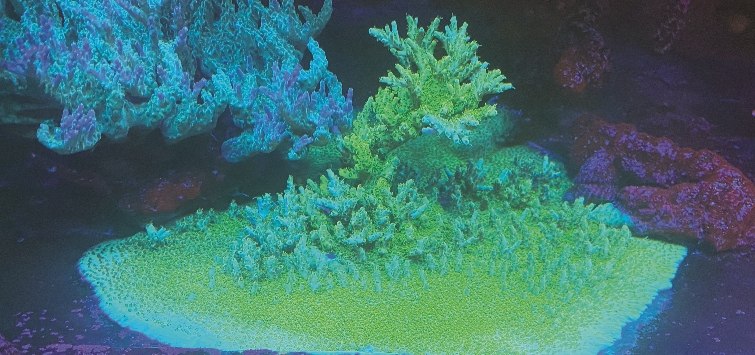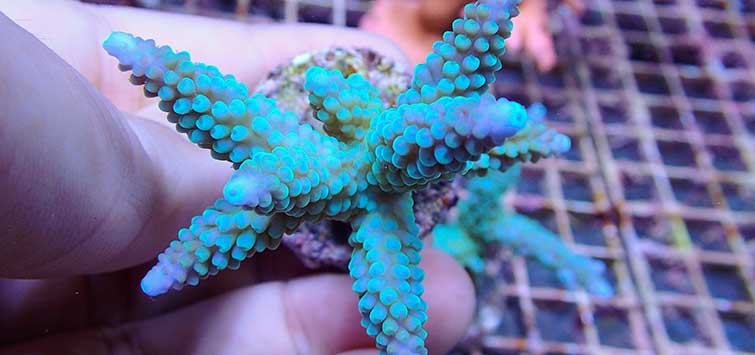Amazing Acropora Corals
Michael Paletta
When most people think of a coral reef, the first thing that usually comes to mind are the large, majestic colonies of Acropora corals shimmering in bright sunlight with lots of small fish darting around. Since the beginning of the hobby, keeping Acropora successfully has been the Holy Grail of the hobby.
For me, my love of all things Acropora began in the 1970s when my father got me Jacques Cousteau’s book Life and Death in a Coral Sea. In it were the first color pictures showing what the fish and corals looked like in the wild. I was immediately hooked and dreamt of keeping these beauties in a tank of my own.
Sadly, it would be more than 15 years later that I—and the hobby itself—developed the skill and techniques to keep these beautiful animals in our own closed systems. It was not for lack of trying. We started keeping soft corals successfully in the 1980s, but it was not until the 1990s that US hobbyists started reading about how German hobbyists were succeeding with Acropora and started to have success over here as well. Fortunately, keeping these corals is now so commonplace that even new hobbyists often start their first tank keeping them.
While there are several other members in family Acroporidae, when one thinks of SPS corals, typically the genus Acropora is what comes to mind. While still challenging, they are much easier to keep nowadays, though the art of maximizing coral coloration is still not easily accomplished.
The Acropora corals kept today are a far cry from the first ones kept in the early 1990s. Then, the majority of Acropora kept were wild colonies that were predominantly brown or beige in color, with an occasional green colony being a rare find. If one was lucky and could get these corals to grow, you might find they had purple or blue growth tips. Compare that with today, when the majority of are raised in a sustainable manner and are either maricultured (farmed from fragments in the sea) or aquacultured (grown in captive environments, also from fragments). Since these are being raised specifically for the hobby, the growers pick the most colorful varieties to work with.
Acropora in the Wild
Before discussing the Acropora coral care and re These corals thrive in warm waters and are the primary reef-building corals of most reefs. They exhibit a wide variety of growth forms, ranging from tabling to arborescent (tree-like), depending on the prevailing conditions. Sometimes the same colony can even exhibit different growth forms due to varying conditions across the large colony.Most of these corals live in the bright sunlit areas of the reef where there is heavy aeration and turbulence. But Acropora are diverse enough that some can also be found in environments far different from what one considers a pristine reef, with some living in deep water or even murky lagoons. As we have learned over the past decades, these corals are quite adaptable, and once they have become adjusted to living conditions, they can thrive.
During the day the polyps of an Acropora coral will extend out and will be visible unless the animal is disturbed or a coral-eating predator is detected nearby. At night, polyp extension is even greater to allow for them to feed on plankton, organic matter, and bacteria, which has been found to be an important food source.
While this feeding can be critical, more than 80 percent of their sustenance has been found to come from their symbiotic relationship with zooxanthellae. One of the reasons that corals were initially thought of as plants was due to their having these algae in their tissues. This relationship is symbiotic: corals not only provide a home for the algae, but their wastes are consumed by the zooxanthellae, which in return provide oxygen and nourishment for the coral.
The coral can even regulate the amount of zooxanthellae in their tissue. They can increase the numbers of zooxanthellae when food or sunlight is scarce, causing the coral’s pigmentation to darken, or when under stress, they can expel it, causing the coral to look pale or even white. When the coral does the latter, it is a form of coral bleaching that can lead to the demise of the colony.
As a result of most corals coming from shallow sunlit reefs, they have developed fluorescent pigments in their tissue to help filter out intense solar radiation. To simplify things, these pigments basically work to help keep the coral from becoming sunburned.
You may have seen instances where a wild reef and its coral inhabitants are exposed to intense sunlight during low tide, where no water is present to help filter the sunlight even a little. Yet despite this, the corals emerge unscathed. The pigments that make this possible can produce a wide variety of colors in the corals depending on various factors. These vivid colors are what have caused these corals to be some of the most in-demand corals in the hobby, and a major improvement over the brown sticks we started keeping over three decades ago.
Aquarium Lighting

Light plays a critical role in the coloration of Acropora, so providing optimum light in our closed systems is critical for coloration. During the early years of keeping, the goal was always to provide as much light as possible. For this purpose, metal halide lights were used and often run for 10 to 12 hours per day.
When we ran this amount and intensity of light, these corals often did well, but they were mostly the brown and beige colors they are when encountered on wild reefs. However, after work done by the likes of Dana Riddle, Steve Tyree and John Burleson, it was determined that this amount and intensity of light may not be necessary. In addition, it was found that if some blue light was added, the coloration of many of these corals could be improved.
With the advent of LED lighting, the method of lighting for Acropora changed dramatically. LED lighting is significantly more adjustable than halides or even fluorescent, in that the intensity, duration, and ratios of the colored diodes can be adjusted in almost limitless detail. This type of lighting also excites more of the pigments, including the fluorescent pigments in these corals, so that under these lights, the colors of these corals changed dramatically. While some miss the shadowing, glitter lines, and full spectrum of halide lighting, most hobbyists prefer the vivid coloration that LEDs provide. In terms of exactly how to light these corals, the general rule is that they do best when they receive between 350 and 450 PAR. However, I have seen these corals thrive when exposed to all channels of the LED source for 9 hours a day, as well as when lit only under the blue spectrum.
In my own tanks, I use powerful LEDs with a modified version of one of the default templates that mimics a gradual onset of daylight. I have it set so that the tank receives maximum lighting for only 7 hours per day, plus the ramp up and down. My modifications are that during the ramp-up phase in the morning, the blue lights are on at 50 percent intensity, and during the ramp-down phase, they are on at full intensity. Each ramp phase lasts for about two hours. In this way, the corals get a strong enough amount of light that they can grow while those blue lights are on, while I can enjoy the vivid coloration that the more balanced programming provides.
LED lighting also provides the opportunity to provide the corals with the full lunar cycle at night. These lights can be programmed so that a low-intensity light that mimics the lunar cycle turns on at night, allowing the corals to receive a low amount of light as they would on the reef. With many, this light waxes and wanes with the lunar cycle. There is a lot of research showing the benefits of lunar cycling, as well as its relationship with spawning cycles.
Since these corals come from shallow reefs, they are not only accustomed to high light, but also to high energy in the form of strong water motion. Strong flow is at least as important to the long-term health of these corals as light.
Maintaining Strong Flow

'
Acropora and most SPS corals have few mechanisms for acquiring food and nutrients and removing waste products and CO2 other than water motion. We have found that part of the best road to success with these corals is to make sure that the flow around them is strong. Most of the individuals I know who have success with these corals provide strong random flow around them, at least 50 times the tank’s volume in terms of flow and even up to 150 times in some tanks.
What this means is that, if the tank Acropora are being housed in is 100 gallons (380 liters), then the flow within the tank should be at least 5,000 gallons per hour (19,000 LPH) and up to 15,000 gallons per hour (57,000 LPH). This strong flow should not be in the form of a single, laminar jet, but a dynamic flow created by many pumps in the tank or sump. Unless the flow is shredding the tissue from the skeleton of the coral, it is good.
Unfortunately, it is difficult to measure flow in specific areas, so we are left with only being able to measure it in gallons per hour based on the rated flow of our pumps. It is even more difficult to measure it when we try to look at the flow in small specific areas.
One way to look at it, in addition to just the gallons moving, is to look for dead spots where detritus settles. Despite our best efforts there will always be a dead spot somewhere in the tank where detritus settles. This can be a good thing if the spot is a place in the tank where it does no harm and can easily be siphoned out. But if the dead spot is on a coral or its base, this can have negative effects.
If this occurs, the flow should be adjusted so that no dead spots occur next to living organisms in the tank. In the best scenario, the flow will be sufficiently random and strong to keep the detritus immn suspension long enough that it will flow out through the overflow and into mechanical filtration.
Obviously, flow will depend on the number of corals being kept. That is, when only a small number of frags are being kept instead of a large number of colonies, the flow will be significantly less. However, as these corals grow and fill in space, the amount of flow should increase accordingly.
Water Conditions

Acropora coral care involves somewhat specific water quality. While some come from lagoons or back reefs with higher loads of nutrients and organics, most of the Acropora we keep come from relatively clean water with low nutrients. We now have a pretty good idea what optimal water chemistry is for them.
For the parameters I am listing, I will put the suggested ranges and then I will list what the experts I have spoken with have found to be the optimal numbers. Please note that if your numbers currently aren’t perfect, do not “chase the numbers” and try to change things quickly. More than the absolute numbers in water chemistry, Acropora corals require stability, as any drastic change can be harmful, so keep this in mind when trying to maintain water chemistry. Calcium 425 to 460 mg/L (with the optimum being 450 mg/L), alkalinity 7 to 10 dKH (optimally 8 dKH), magnesium 1350 to 1450 mg/L (optimally 1400 mg/L), pH 7.8 to 8.5 (optimally 8.2 to 8.4), phosphate 0.05 to 0.15 mg/L (optimally 0.08 to 0.1 mg/L), and nitrate 2.5 to 15 mg/L. The optimum for phosphate and nitrate varies, but from my research is best when there is at least a 50:1 and up to a 100:1 ratio of nitrate to phosphate.
It should be noted that if alkalinity is kept on the low side, then the nutrient levels should also be low, and conversely when alkalinity is run higher, then the nutrient levels should be run higher. An additional caveat to this is that, when lighting is run at a higher PAR—such as above 500—the alkalinity and nutrient levels should also be run on the high side.
Water chemistry is much more variable than any other factors for successfully keeping Acropora. Some parameters like alkalinity can change dramatically in a single day, while others like magnesium may take weeks for any change to be noticeable. For these reasons, water testing, especially of alkalinity and pH, should be done daily. But again, numbers should not be chased, and any changes should be done as gradually as possible, over days, or better, weeks.
When all of the above-mentioned water parameters and conditions are met, Acropora can thrive and grow at astounding rates. In some cases, they may even grow faster in our closed systems than they do on the wild reef.
Feeding
One relatively recent change is our better understanding of coral nutrition. We now know that many corals do best when their nutritional requirements are met through feedings. Fortunately, there are now a wide variety of foods available to supply these needs, including live phytoplankton, as well as frozen and dried foods.It should also be noted that there is some evidence that the main food source for many of these corals is bacteria, so when we add “coral food,” what we are actually doing is feeding the bacteria that the corals feed on.
Pests and Treatment
When looking at any natural reef, it quickly becomes clear how successful Acropora corals are in the wild, and the same is true when looking at many reef tanks today. Unfortunately, along with this success comes something that can’t be avoided: pests. Acropora corals are prone to more pests than just about any other coral I have kept.
There are fish that only eat coral polyps, but there are also crabs that hide within the colony and gradually clear away entire areas of tissue. There are nudibranchs and various mollusks that come out at night to feast on them, and there are even Acropora-eating sea spiders, amphipods, copepods, and other little beasties too numerous to name. However, as bad as these pests are, the one nuisance organism that most hobbyists fear the most is Acropora-eating flatworms, or AEFW. This acronym casts fear in any hobbyist unfortunate enough to encounter them.
For this reason, every newly acquired Acropora should be dipped and quarantined before being added to a display tank. Sadly, I know that few of us quarantine these corals, so a good dip and careful examination of the corals should be done before they are added to a tank.
In addition, I suggest that natural predators for these pests be kept in any tank housing Acropora. In my own tanks I keep Springer’s damsels, yellow wrasses, melanarus wrasses, and six-line wrasses. These natural predators do a pretty good job of keeping any pests at manageable levels. However, from time to time it has been necessary to use chemical methods for eradicating these pests. These treatments cannot be discussed here, but will be the focus of a future article. As with most things, prevention is far better than having to cure the issue.
Growing Our Knowledge

Acropora corals are among the most beautiful and popular corals in the hobby. Over the past 30 years they have gone from being brown sticks that were thought impossible to keep to the little jewels that are the focus in many tanks.
As our knowledge base regarding Acropora coral care and requirements continues to increase, I expect that over the next few years spawning, hybridization, and other once-thought-impossible aspects of keeping them will continue to become increasingly common.
I also expect that, along with this, we will also obtain a better understanding of their diseases and nutritional needs. And hopefully, all of this will help us if, at some point, we need to replenish the reefs from our captive stock.

.png?h=595&iar=0&w=2781&hash=5FD5E69473BCC22199FBFA2FB71B6033)



